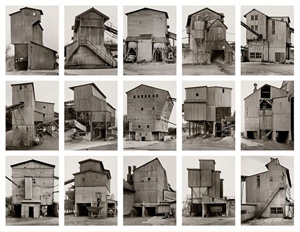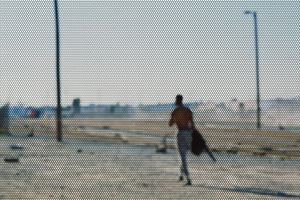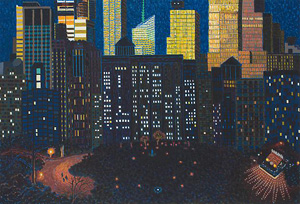Achieving Banality
John Haberin New York City
Bernd and Hilla Becher
Anthony Hernandez and Yvonne Jacquette
I had returned to a city that could not be bothered to welcome me home. Night after night, through the windows of an illegal loft, I found relief in the rooftops that looked so faceless from the street below.
They must have hid stories so different from mine, but the darkness itself was common ground. So were the water towers, every one of them a human product—and every one with a distinct history and form. They could almost have been speaking to me.  They must have spoken to Bernd and Hilla Becher as well. On a visit those same years, they photographed New York's water towers and nothing else. In the late 1970s and in years to come, they catalogued the industrial infrastructure of post-industrial cities.
They must have spoken to Bernd and Hilla Becher as well. On a visit those same years, they photographed New York's water towers and nothing else. In the late 1970s and in years to come, they catalogued the industrial infrastructure of post-industrial cities.
The Met calls them "archetypical," but they were not mere types. For Hilla Becher, they were "objects that reappeared in different countries," like old friends. Could I have dismissed their photos as banal all the same? A retrospective shows how much it took to achieve banality. Anthony Hernandez, in turn, defies complacency by placing his cities behind a screen that could pass for an industrial fence. This is, he insists, not just private property but urban life.
In her sketches, Yvonne Jacquette liked to close in on a traffic light, the kind that hangs over the center of an intersection. Mostly the color speaks for itself, as colors do in art, but every so often the signal makes its message explicit: Don't Walk. But you knew that. Who, after all, can walk into the sky? The artist, who died not two weeks before her opening in Chelsea, was exceptionally grounded, but she had a talent for lifting you off your feet and lifting your eyes to the sky.
The typology of towers
Bernd and Hilla Becher knew the industrial heartland cold, only starting with Düsseldorf, their home city. It was a short trip to Zeche Concordia and the coal country of western Germany. There they staked out a vocabulary of mineheads, blast furnaces, and cooling towers. They could step back for a view of the industrial landscape—or close in for the blank face of grain silos, gas tanks, and water towers. They cropped them up close, like portraits, but displayed them in grids with their own technical architecture. The Met divides the show into sections, roughly by subject and roughly chronologically, from "basic forms" to "typologies."
Not that the photographers accepted those terms. More than you may ever have realized, they also had an eye for differences and detail. They found kinks in even the closest approximations to symmetry. They brought out the sharp angles of pipes and conveyor belts carrying aloft the coal slag and the eye. The structures are going nowhere, but everything inside them is in motion, except where it lies abandoned. If the Bechers exclude people, they speak to a human presence and a present abandonment.
They also speak to history. They traveled to working class Manchester, like Friedrich Engels in 1844, and to Youngstown, Ohio, once a synonym for the vitality of America's heartland. They curators, Jeff L. Rosenheim with Virginia McBride, see the photographers as heirs to Walker Evans and August Sander, who could not get enough of people in the Depression and in cities. The Bechers also taught Thomas Struth, Andreas Gursky, Candida Höfer, and Thomas Ruff. Each has a love for precision and works in series, but with subjects like the libraries, museums, and fine art of Europe. In making photography an art form, the Bechers inspired more overt artistry than they could ever have dreamed.
The Met worked with their son, Max, and Gabriele Conrath-Scholl, director of the Photographische Sammlung/SK Stiftung Kultur in Cologne, which hosts their archives. It has a whole room for residential structures, their framework visible in crossing diagonals on the outside, as in a chalet. Later grids dare one to distinguish towers of wood and steel. It sounds glib to see an industrial lattice as a "veritable Eiffel Tower," but now and again the resemblance is unmistakable. A. G. Eiffel, too, aspired to technical form. How, then, could I have dismissed their work as banal—all the more so when Minimalism and conceptual art take banality as a compliment?
For an answer, imagine for a moment that Bernd and Hilla Becher were American. They might capture façades with all the crisp modernity of painting by Charles Demuth and Charles Sheeler or abstract away. And the show in fact includes an open cube by Sol LeWitt and tin floor tiles by Carl Andre, who owned work by the Bechers as a gift or in trade. They might be closer, too, to documentary photography with an implicit politics, like Robert Frank, or to Pop Art's irony and enthusiasm. By contrast, their ramshackle structures in black and white approach nostalgia and a suitably German humorless obsession. Yet they earned their banality, and it took time.
Born in 1931, Bernd began in prints and cutouts with the bold, flat colors of early Soviet art and the American modern. Three years younger, Hilla infused industrial structures and leaves alike with organ form and interior light. Slowly, they closed in on autonomous forms and the grid. They described it as ridding images of context, and one grid gathers forty-nine towers, each with a separate function so that none has its say. Alternatively, they were giving what they saw a new context, in the banality of late modern art. By their deaths in 2003 and 2015, they had found a context, too, in the anonymity of postmodern life.
Private screenings
It is perfectly safe to look at "Screened Pictures," by Anthony Hernandez. His subjects are, after all, at a safe distance and safely behind a fence. It is not so safe to venture a guess as to who they are. Is that silhouette of a man standing comfortably beside a tree, its branches and leaves arching gently above? Or is he forever lost in weariness and shadow? Is a pair in the park on another sunny day lolling in the grass or gearing up for a fight?
Things may look still more ominous when photos abandon the greenery for a stark urban landscape, but the sun still beats down. A man beside a one-story building only brings out its harsh yellow extending across the picture. A woman might heading home or into a war zone. As for the shadowy figures in the niches or windows of another one-story building, forget ambiguity. I have no idea what they are doing. They might be sheltered, gainfully employed, in a police lineup, or trapped.
 Hernandez does not offer much in the way of clues. Titles merely repeat that of the exhibition and series. It refers to the black screen covering each and every picture, like a chain-link fence with unnaturally small links. It leaves his scenes in a blur, for all their sharp focus. It adds dark overtones to all his subjects, leaving them behind the fence. It does nothing to temper his heightened contrast, as the sun bears down and the figures remain shadows.
Hernandez does not offer much in the way of clues. Titles merely repeat that of the exhibition and series. It refers to the black screen covering each and every picture, like a chain-link fence with unnaturally small links. It leaves his scenes in a blur, for all their sharp focus. It adds dark overtones to all his subjects, leaving them behind the fence. It does nothing to temper his heightened contrast, as the sun bears down and the figures remain shadows.
Then again, it is all his doing, and the screen calls attention to his artifice. He takes care with his compositions, like the branches and trunk that bend in response to the curve of a man's body or the buildings parallel to the picture plane. If they risk cliché, movies are screened pictures, too, and these are your private screenings. The links themselves are not a fence but a photographer's device. Besides, if they were a fence, it might keep his subjects in or keep you out. You might even appreciate the implied distance and enjoy imagining the worst.
The anonymity of the urban landscape can easily become a photographer's obsession. Think of Bernd and Hilla Becher in Germany, and the screen corresponds to Minimalism's grid, much like their towers arranged in series. Still, it can become an obsession because industrial development is unrelenting, too. It can also be oblivious to how the best of intentions for a more comfortable city play out. Hernandez takes that as his theme, and it becomes more obvious still when he turns to smaller images without the screen, in black and white. There he heads for Syracuse, in upstate New York, which seems to have mistaken imposing real estate for the revival of downtown.
Older buildings look impressive, but their very breadth discourages pedestrian traffic, as does the open space between them and the camera. Attempts to create public plazas look like Brutalism run mad—or run short of finished architecture. Large concrete blocks must make for uncomfortable seating, and Hernandez sticks to figures on their own to bring out the felt discomfort and isolation.. Pleas for pocket parks and garden cities start to sound a lot more plausible. Just remember that he is imposing his own urban vision, in the interest of real people and of art. These are, at least figuratively, screened pictures, too.
Don't Walk
Yvonne Jacquette made a name with overhead views of New York, precariously up or sweepingly down. She captured its buildings and its traffic, the first often famous, the second so infamous, but here the city never stands still. Streaks of color, in slim, bright horizontal strokes, animate its Art Deco towers and the sky. For those traffic lights, she must have looked right out her window, much as Bernd and Hilla Becher stared at water towers not long after. Just as often, though, she captured the view from a plane or helicopter, much as Georgia O'Keeffe drew desert highways from her window seat. For both, the scene below was and was not the same.
The same gallery looked at Jacquette's city from the sky in 2014, with later work, but it has two different series instead, both from the mid-1960s through mid-1970s. One sticks close to her New York apartment, and I mean close, with close-ups of household objects and architecture. The other series moves between its surroundings and her house in Maine, amid a small community of artists and critics, including Alex Katz. Together, they present her as more of a still life and landscape painter. They bring her closer to the ground, where things have a way of pressing in. Yet they make it easier to understand what swept her off her feet. 
She is still manipulating her point of view, but now the view at arm's length. She cuts off much of a TV set except for its aerial, which casts two distinct shadows on the wall. A steel chair's shadow stubbornly refuses to match up with it, while the shadow of a decorative grille stands alone, with no trace of what lies out the window. What looks at first like floor tiles are the ceiling, squeezed close against an open door. Entire train cars run along the apartment floor, but they are only her son's model trains. You can almost piece together the light sources, the furnishings, and the architecture, if you dare.
The world outside is more comforting, but still strange. Both residences live up their billing well enough. Maine has its idyllic sunlight, New York its vibrancy at night. Flowers take broad smudges, urban skies those insistent horizontals. To New Yorkers, country life has too many cars and maybe a few too many boats, while New York to Maine has its blank walls and dead ends—but then things really get going. Much as with that steel chair, Jacquette offers nowhere to sit. Still, as a title has it, Things Are Looking Up.
Water towers are still a reliable fixture on the city skyline, but with uncanny leaps between one roof and the next. Those glorious color streaks blur the distinction between gray concrete and a burning sky, and sunlit clouds seem fiery as well. A river in Maine breaks across two grounds without quite adding up. Its recreational traffic seems all the more still for that. Back inside, attic beams change in direction and from blond to dark wood as they cross. That tin ceiling near to abstraction has nothing on this.
Not that she is out to make you lose your bearings. She is out to make you look again. She follows lavish still life at the same gallery, by Robert Kushner and then Janet Fish, but Jacquette does not revel in excess. She just exceeds expectations. An artist sometime numbered among New Realists for a painting with James Bond in the title has to know her expectations and yours. She has to know when to fly and when to walk.

Bernd and Hilla Becher ran The Metropolitan Museum of Art through November 6, 2022, Anthony Hernandez at Yancey Richardson through October 22. Yvonne Jacquette ran at D. C. Moore through June 17, 2023.




